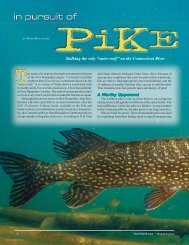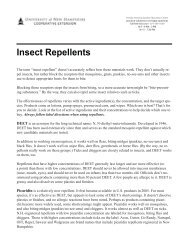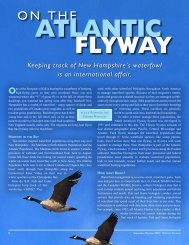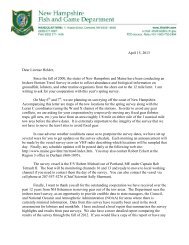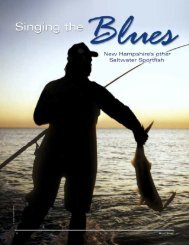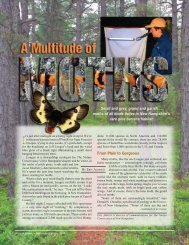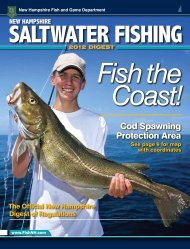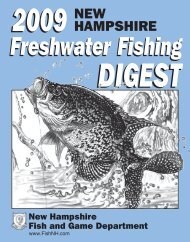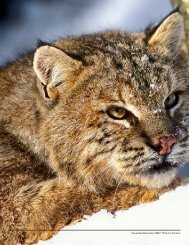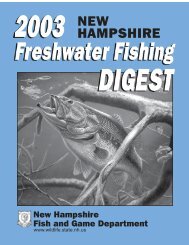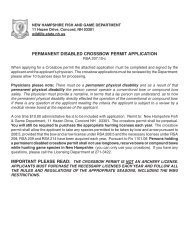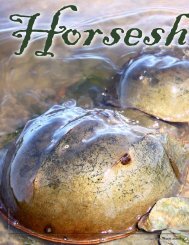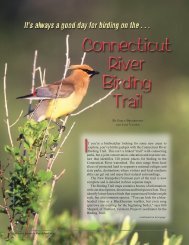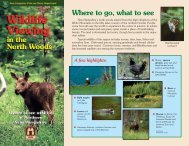Dover - New Hampshire Fish and Game Department
Dover - New Hampshire Fish and Game Department
Dover - New Hampshire Fish and Game Department
You also want an ePaper? Increase the reach of your titles
YUMPU automatically turns print PDFs into web optimized ePapers that Google loves.
“Picking Our Battles”: An Invasive Plant Control Strategy for <strong>Dover</strong>, NHA town <strong>and</strong> l<strong>and</strong>scape scale community collaboration to helprestore the native biodiversity of <strong>New</strong> <strong>Hampshire</strong>.Priority Areas for Invasive Plant ManagementInvasive plant Speciesin <strong>Dover</strong>NHighLowThe dark areas are“hot spots” forinvasive plantcontrol. Thedarker the area,the more likelymanagementwill both preventinvasive plantspread to newareas <strong>and</strong> protectcritically sensitivenatural resources.These species of invasive plant have not yet fullytaken root in <strong>Dover</strong>. This means they are theeasiest battles to fight. Early detection <strong>and</strong> rapidresponse to control small populations of thesespecies might prevent them from becoming fullyestablished in your municipality.• Blunt-leaved privet(Ligustrum obtusifolium)• Dame’s rocket(Hesperis matronalis)• Garlic mustard(Alliaria petiolata)No one knows your municipality like you. If you wouldlike to suggest updates to this list, pleasecontact douglas.cygan@agr.nh.govRestoration is a Full Circle ...Invasive plant species are early colonizers of disturbed soils.Once you have cleared an area <strong>and</strong> exposed bare ground,remember to plant with native species as soon as possible.... Pull, then Plant!Version 1.0, Jan. 2013
How “Hot Spots” for Invasive Plant Control were Identified:+ +Ecological Significance Ecological Services Provided Potential for Spread to <strong>New</strong> AreasThe model on the previous page was created from three composite layers. These layers represent areas of high ecological significance, areas that provideecological services to human activities, <strong>and</strong> areas that, if invasive plants are present, have a high risk of spreading to establish new populations. The modelsupports a l<strong>and</strong>scape scale prioritization strategy customized for your municipality. More details about the strategy, <strong>and</strong> suggestions of how to prioritizerestoration at the individual property scale, can be found at www.wildnh.com/invasives.For More Information about Upl<strong>and</strong> <strong>and</strong> Wetl<strong>and</strong> Invasive PlantsContact your UNH Cooperative Extension County Forester at259 County Farm Road, Unit 5, <strong>Dover</strong>, NH 03820. Phone: (603) 749-4445Check out the “<strong>New</strong> <strong>Hampshire</strong> Guide to Upl<strong>and</strong> Invasive Species”. NH Dept. ofAgriculture Markets <strong>and</strong> Food, Plant Industry Division. 2nd Edition, 2010 availableat www.nh.gov/agric/divisions/plant_industry/documents/invasive-species.pdfThis model was created with input from over120 individuals, community groups, academics<strong>and</strong> natural resource professionals. The projectwas coordinated by the NH <strong>Fish</strong> <strong>and</strong> <strong>Game</strong><strong>Department</strong>, NH Natural Heritage Bureau, <strong>and</strong>Great Bay National Estuarine Research Reserve.Version 1.0, Jan. 2013



